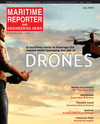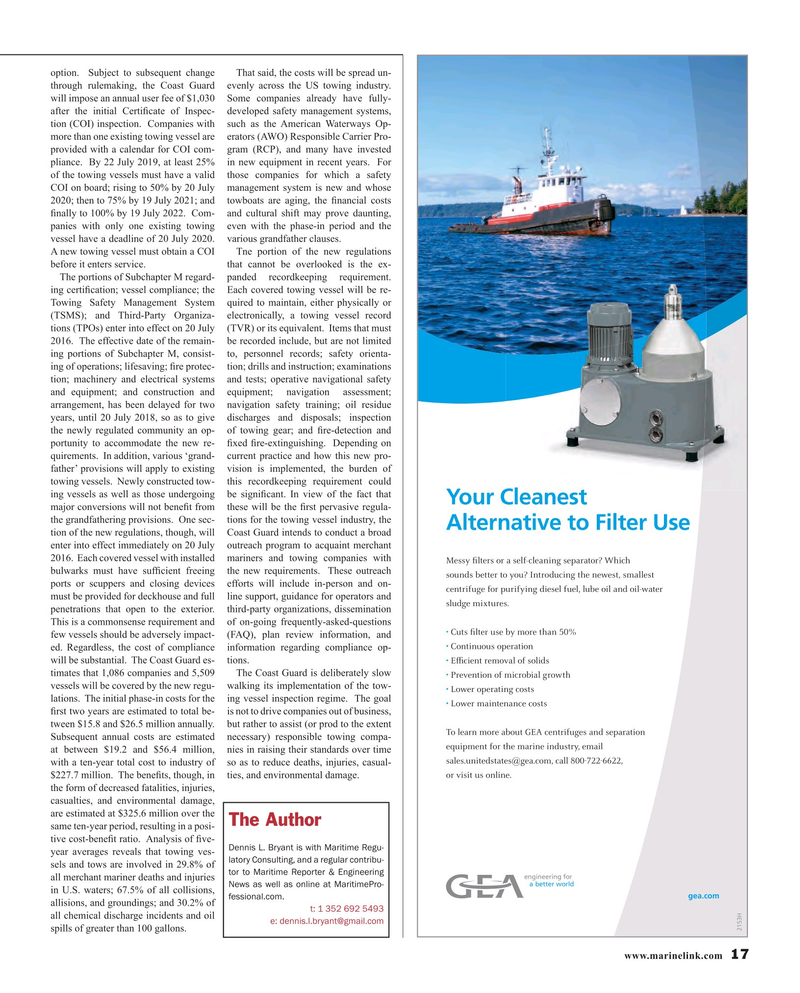
Page 17: of Maritime Reporter Magazine (July 2016)
Marine Communications Edition
Read this page in Pdf, Flash or Html5 edition of July 2016 Maritime Reporter Magazine
option. Subject to subsequent change That said, the costs will be spread un- through rulemaking, the Coast Guard evenly across the US towing industry. will impose an annual user fee of $1,030 Some companies already have fully- after the initial Certi? cate of Inspec- developed safety management systems, tion (COI) inspection. Companies with such as the American Waterways Op- more than one existing towing vessel are erators (AWO) Responsible Carrier Pro- provided with a calendar for COI com- gram (RCP), and many have invested pliance. By 22 July 2019, at least 25% in new equipment in recent years. For of the towing vessels must have a valid those companies for which a safety
COI on board; rising to 50% by 20 July management system is new and whose 2020; then to 75% by 19 July 2021; and towboats are aging, the ? nancial costs ? nally to 100% by 19 July 2022. Com- and cultural shift may prove daunting, panies with only one existing towing even with the phase-in period and the vessel have a deadline of 20 July 2020. various grandfather clauses.
A new towing vessel must obtain a COI Tne portion of the new regulations before it enters service. that cannot be overlooked is the ex-
The portions of Subchapter M regard- panded recordkeeping requirement. ing certi? cation; vessel compliance; the Each covered towing vessel will be re-
Towing Safety Management System quired to maintain, either physically or (TSMS); and Third-Party Organiza- electronically, a towing vessel record tions (TPOs) enter into effect on 20 July (TVR) or its equivalent. Items that must 2016. The effective date of the remain- be recorded include, but are not limited ing portions of Subchapter M, consist- to, personnel records; safety orienta- ing of operations; lifesaving; ? re protec- tion; drills and instruction; examinations tion; machinery and electrical systems and tests; operative navigational safety and equipment; and construction and equipment; navigation assessment; arrangement, has been delayed for two navigation safety training; oil residue years, until 20 July 2018, so as to give discharges and disposals; inspection the newly regulated community an op- of towing gear; and ? re-detection and portunity to accommodate the new re- ? xed ? re-extinguishing. Depending on quirements. In addition, various ‘grand- current practice and how this new pro- father’ provisions will apply to existing vision is implemented, the burden of towing vessels. Newly constructed tow- this recordkeeping requirement could ing vessels as well as those undergoing be signi? cant. In view of the fact that
Your Cleanest major conversions will not bene? t from these will be the ? rst pervasive regula- the grandfathering provisions. One sec- tions for the towing vessel industry, the
Alternative to Filter Use tion of the new regulations, though, will Coast Guard intends to conduct a broad enter into effect immediately on 20 July outreach program to acquaint merchant 2016. Each covered vessel with installed mariners and towing companies with
Messy ?lters or a self-cleaning separator? Which bulwarks must have suf? cient freeing the new requirements. These outreach sounds better to you? Introducing the newest, smallest ports or scuppers and closing devices efforts will include in-person and on- centrifuge for purifying diesel fuel, lube oil and oil-water must be provided for deckhouse and full line support, guidance for operators and sludge mixtures.
penetrations that open to the exterior. third-party organizations, dissemination
This is a commonsense requirement and of on-going frequently-asked-questions • Cuts ?lter use by more than 50% few vessels should be adversely impact- (FAQ), plan review information, and • Continuous operation ed. Regardless, the cost of compliance information regarding compliance op- will be substantial. The Coast Guard es- tions. • E?cient removal of solids timates that 1,086 companies and 5,509 The Coast Guard is deliberately slow • Prevention of microbial growth vessels will be covered by the new regu- walking its implementation of the tow- • Lower operating costs lations. The initial phase-in costs for the ing vessel inspection regime. The goal • Lower maintenance costs ? rst two years are estimated to total be- is not to drive companies out of business, tween $15.8 and $26.5 million annually. but rather to assist (or prod to the extent
To learn more about GEA centrifuges and separation
Subsequent annual costs are estimated necessary) responsible towing compa- equipment for the marine industry, email at between $19.2 and $56.4 million, nies in raising their standards over time [email protected], call 800-722-6622, with a ten-year total cost to industry of so as to reduce deaths, injuries, casual- or visit us online.
$227.7 million. The bene? ts, though, in ties, and environmental damage.
the form of decreased fatalities, injuries, casualties, and environmental damage, are estimated at $325.6 million over the
The Author same ten-year period, resulting in a posi- tive cost-bene? t ratio. Analysis of ? ve-
Dennis L. Bryant is with Maritime Regu- year averages reveals that towing ves- latory Consulting, and a regular contribu- sels and tows are involved in 29.8% of tor to Maritime Reporter & Engineering all merchant mariner deaths and injuries
News as well as online at MaritimePro- in U.S. waters; 67.5% of all collisions, fessional.com. allisions, and groundings; and 30.2% of t: 1 352 692 5493 all chemical discharge incidents and oil e: [email protected] 2153H spills of greater than 100 gallons. www.marinelink.com 17
MR #7 (10-17).indd 17 7/6/2016 9:56:58 AM

 16
16

 18
18
